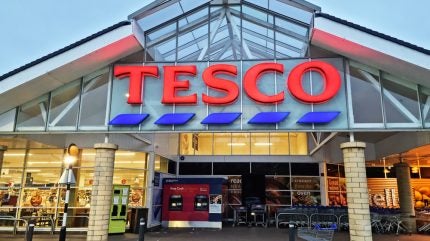
Tesco, the UK’s largest supermarket group, has posted a rise in adjusted operating profits and sales for the 2024/25 financial year, as it gained market share and improved customer satisfaction.
However, free cash flow declined compared to the previous year, and statutory profits dipped due to one-off impairment charges.
Adjusted profit up, statutory measures down
Tesco reported an adjusted operating profit of £3.13bn, up 10.6% from the previous year, driven by strong performance across both its UK and international operations. Retail profit increased 7.7% to £2.97bn, supported by improvements in volumes and operational efficiency.
Group sales, excluding VAT and fuel, rose 3.5% to £63.6bn. However, on a statutory basis, operating profit fell by 3.9% to £2.71bn, while profit before tax dropped 3.2% to £2.22bn. This decline was largely attributed to a £286m non-cash impairment charge linked to rising government bond yields.
Adjusted earnings per share rose 17% to 27.38p, while the dividend per share increased 13.2% to 13.70p. In contrast, statutory diluted earnings per share fell 5.7% to 23.13p.
Free cash flow falls but debt reduced
Tesco’s free cash flow fell by 15.2% to £1.75bn, down from £2.06bn in the previous year. The company said last year’s figure was boosted by higher trade payables amid increased input cost inflation. Despite the cash flow decline, Tesco reduced its net debt by 2.4% to £9.45bn.
Capital expenditure rose to £1.46bn, reflecting continued investment in store improvements, automation, and digital services.
The retailer aims to deliver a further £500m in savings next year through its “Save to Invest” programme to help offset operating cost pressures, including higher National Insurance costs.
Growing online and expanding digital services
Tesco strengthened its position as the UK’s leading supermarket, increasing its market share by 67 basis points to 28.3%, the highest level since 2016. The group achieved gains for 21 consecutive four-week periods, while also reporting a 10.2% rise in UK online sales and higher customer satisfaction.
Digital expansion included wider use of its Clubcard loyalty programme, now reaching 84% of UK transactions, and the growth of its rapid delivery service, Whoosh, which now covers over 1,500 stores. Tesco also launched its own online marketplace, offering more than 400,000 third-party products.
Tesco’s media and retail data platform also grew, with over 9,000 campaigns delivered and increased advertiser engagement, positioning it as a growing revenue stream.
Outlook and further share buybacks
Looking ahead, Tesco expects adjusted operating profit for 2025/26 to be between £2.7bn and £3.0bn, slightly below this year’s result. It forecasts free cash flow to remain within a range of £1.4bn to £1.8bn.
The company also announced a new £1.45bn share buyback programme to be completed by April 2026, supported by ongoing free cash flow generation and proceeds from the sale of its banking operations. This follows the completion of a £1bn buyback in April 2024.
Tesco’s CEO Ken Murphy said the group remains committed to offering customers strong value and convenience while continuing to invest in long-term growth areas such as automation, loyalty, and digital retail.



